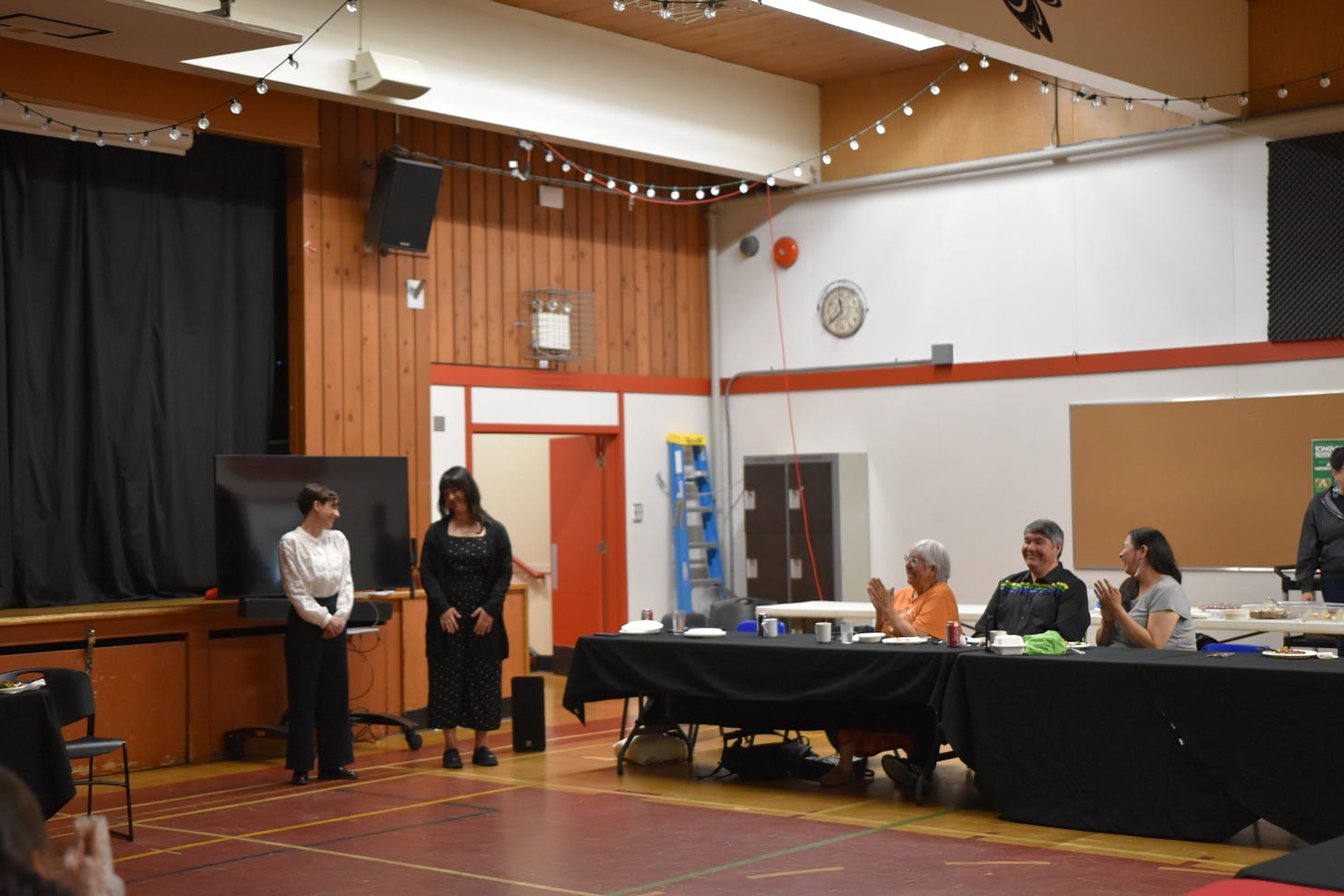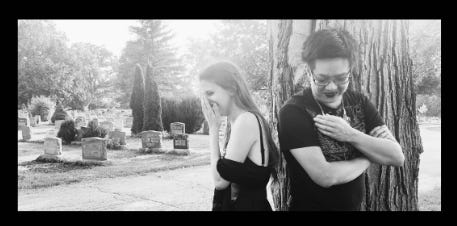Golden tropft Blatt um Blatt Golden falls leaf upon leaf Nieder vom hohen Akazienbaum. Down from the high acacia tree. Sommer lächelt erstaunt und matt Summer smiles, astonished and weak, In den sterbenden Gartentraum. In the dying garden's dream. - “September,” Hermann Hesse (Vier letzte Lieder, Richard Strauss)
Dear readers, welcome to Art Song Canada’s Fall 2024 Edition! This issue explores the communal aspects of art song performance and creation, featuring writers from across Canada. From British Columbia, mezzo-soprano and civic engagement specialist Rebecca Hass describes how art song performers in Victoria are collaborating with Indigenous Elders and language speakers to translate canonic works into their languages. Over in Halifax, soprano Maureen Batt interviews composers and poets for a look at the collaborative aspects of song creation, focusing on Fiona Ryan’s “Lady of the Lake” and Saman Shahi’s “Breathing in the Shadows.” Finally, art song enthusiast Dr. Don Melady recounts a communal exploration of Schubert’s Winterreise that began over the pandemic and culminated in two Liederabende performed in Toronto last spring (cet article est également disponible en français).
Following our featured articles, we continue with our Introducing… series for little-known song cycles, this time looking at Xavier Leroux’s La solitaire.1
Thank you for reading with us. If you enjoy this issue, please consider donating to support the Art Song Foundation of Canada’s bursary programs for young Canadian singers and pianists. Allons-y!
— Sara Schabas, editor
Indigenous Language Art Song Project by Rebecca Hass, mezzo-soprano, composer, community-builder
At Pacific Opera Victoria (POV), I design programs and build community partnerships. In my own compositional practise, I am fascinated by how the language of different nations reflects worldview, the land, and the people. As a classical singer, and a person of Métis ancestry, I have been active in singing and composing songs for local urban Indigenous drum groups for the last few years. It was this very personal journey of Indigenous language and song that inspired me to create a bridge between the classical European musical world and my Indigenous community.
I envisioned a song translation program that could help build an authentic relationship between POV and Elders who are speakers of their community’s languages. This would support the work of Reconciliation, POV, and our Indigenous community by showcasing the Indigenous community’s languages in action. This past spring, Pacific Opera hosted two artists-in-residence - Camila Montefusco and Nicole Ross - and their residency seemed the perfect opportunity to explore this idea.
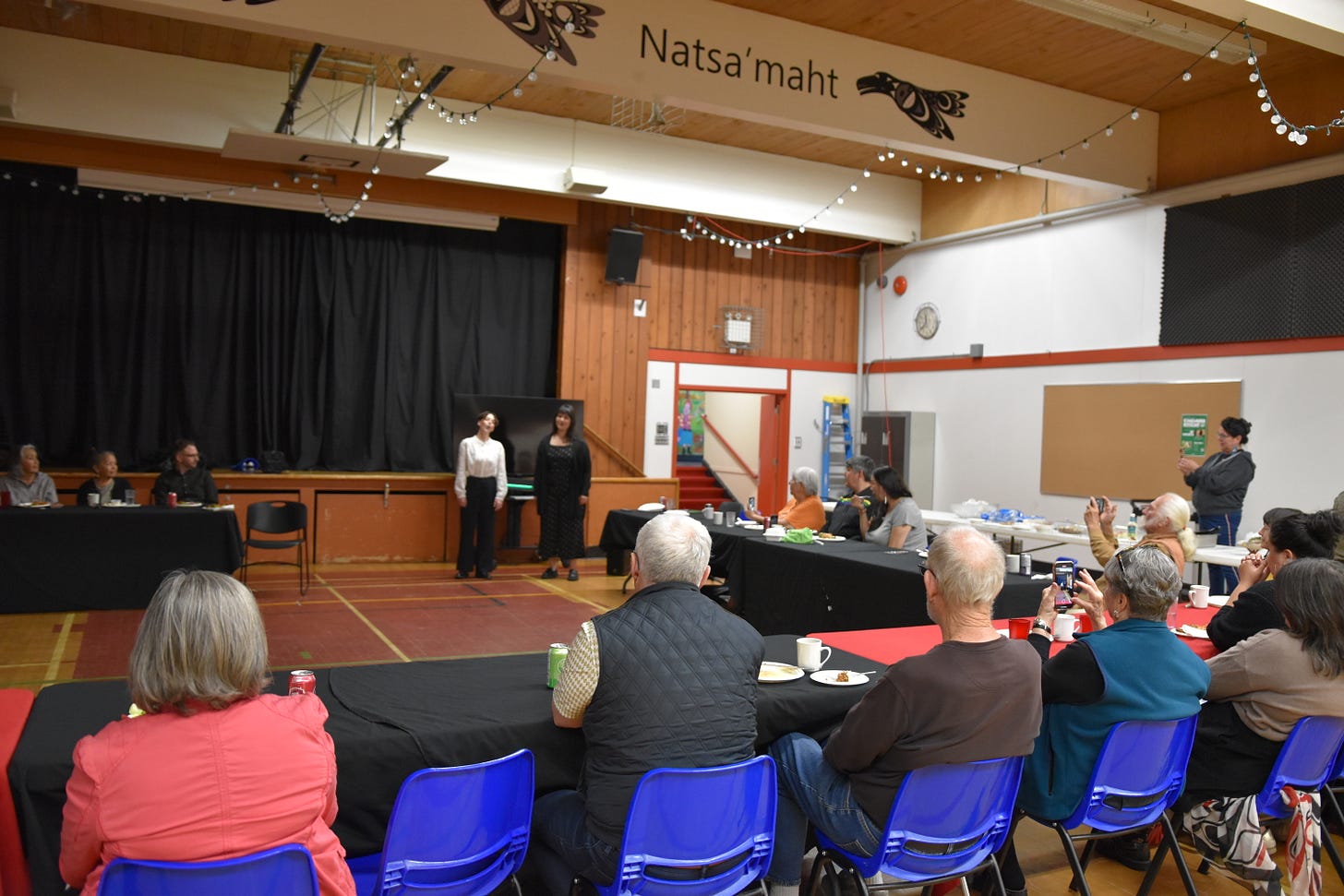
Despite the immediate excitement to engage in this work, this project was challenging for the company and the artists involved. In our work in classical music, we have preconceived notions about how we prepare pieces and what a successful performance looks like. For example, to work with the Indigenous Elders who would be our translators, a relationship between the company, the artists and the Elders had to be forged. Rather than racing to prepare for the lunch performance at the Victoria Native Friendship Centre, time was taken for tea, snacks, and visiting. Much more time was spent visiting than in traditional practice or rehearsal time. Throughout the process, I asked the artists to trust that success in this project would be measured by the good relationships that we were building, rather than the professional quality of the upcoming performance.
Two months ahead of the performance, I asked the singers to send me a few art songs in the vein of a folk song with a simple story in any language. From what they each sent me, I looked at song lengths, the poetry, and the nature of the melodic line. Once I selected the song that I felt would be most successful in translation, I considered the singers’ personalities and matched them to an Elder for the process. I built relationships with two Elders ahead of time, and worked with the translations they developed, fitting them into the pieces and making sure that the musical structure supported the words so it all made sense. As it turns out, Anishinaabe words are much longer than Russian and English words which meant I had to choose to cut some text in one of the songs.
“How Fair This Spot” (Opus 21) by Sergei Rachmaninoff with text by Glafira Adol'fovna Galina was translated into Anishinaabe by Elder Aldeen Mason of the Sagkeeng First Nation. Manual de Falla’s “Nana” (Siete Canciones de populares Españolas, anon. poet) was translated into Nu-Chah-Nulth by Ahousat Elder, Genevieve Mack. Rachmaninoff’s song features imagery from the natural world while the de Falla song is a lullaby.
Both of the poems selected resonated with the Indigenous speakers. However, translating European repertoire into Indigenous languages led to challenges. In the Rachmaninoff, we encountered the word ‘meadow’, for which there is no Anishinaabe word. Aldeen translated it to ‘grasses’, which is what she imagined when she thought of the fields in her home territory outside of Winnipeg. Nicole Ross, who had sung the song often in Russian, noted that the vowel placement in Anishinaabe resembled the Russian text. For the de Falla, Genevieve described the syllables and sounds in Nu-chah-nulth that are used to rock a baby. She sang us a lullaby her mother used to sing and explained the words in her language for the startle cry of a baby awakened from a nap.
The final private session with the singers and the speakers was a tear-filled afternoon. Genevieve recounted her experiences at Residential school being punished for speaking her language. She told us that to have artists come to visit and take the time to learn her language and sing a beautiful song to her was a moment of great happiness and gratitude. Our resident artists performed these songs in a small program at an Elders’ lunch hosted at the Friendship Centre. Our Anishinaabe speaker, Aldeen, was so excited and proud that she invited her family along.

For me, this project confirmed the value of relationships when music-making and the power of music-making beyond the aesthetic. Our project built bridges and created excitement and interest in the community to continue. This season I will be undertaking six more translation projects with other Indigenous languages and speakers. I can’t wait to continue visiting, drinking tea, and making music for our community. Mezzo-soprano and artist-in-residence Camila Montefusco summed it up perfectly when she shared this with me at the end of the program:
“Having the chance to translate a classical piece to an Indigenous language and perform it during our residency shows me yet another way in which music can serve as a cultural bridge. It opened the doors to what I believe is possible for the future of our art form.”
Rebecca Hass (Nitaawe giizhigok/ singing sky woman) is a singer, arts administrator, mentor, writer and creative living coach who has been a grateful visitor on Lekwungen territory since 2005. A mixed blood woman (Georgian Bay Métis, French, German, British) she is currently the Director of Engagement Programs and New Work for Pacific Opera and was the winner of the Nada Ristich Change Maker Ruby from Opera Canada for 2022.
The Cast and Creative Team of Art Song and Art Song Cycles by Maureen Batt, soprano
The communal aspects of art song are what excite me; how we connect over a shared experience (astrological events, Olympics, a stunning flower, or the smell of a new season), or over a desire to understand, interpret, and be in dialogue with someone else’s creative work. My experience with art song embodies community.
While art song only requires a singer and pianist to be performed, the creative ensemble also includes the poet and the composer. Looking further, another three collaborators are revealed: the inspiration for the text, the inspiration for the composer to set that text, and the inspiration for the singer to perform the work. Those three layers of connection are entities in their own right.
The dance among text, melody, narrative, and interpretation examines the form and the versatility of the song cycle as a genre. Pianist Simon Docking writes:
I think at its best, the song cycle experience lends itself to an interior intensity that can match the exterior intensity of opera. A cycle projects the emotional journey on a much wider time-screen [than a single song], and can take us to many more places. The cycle provides a way the composer can easily imply a "cut" in time, like the title card in a movie ("Three Weeks Later" etc.). Fiona [Ryan]'s “Lady of the Lake” is unusual, because it's a single-poet cycle, with a narrative, but it presents vignettes from the narrative rather than the whole thing[…], both more dramatic than the classic German cycles and less direct.
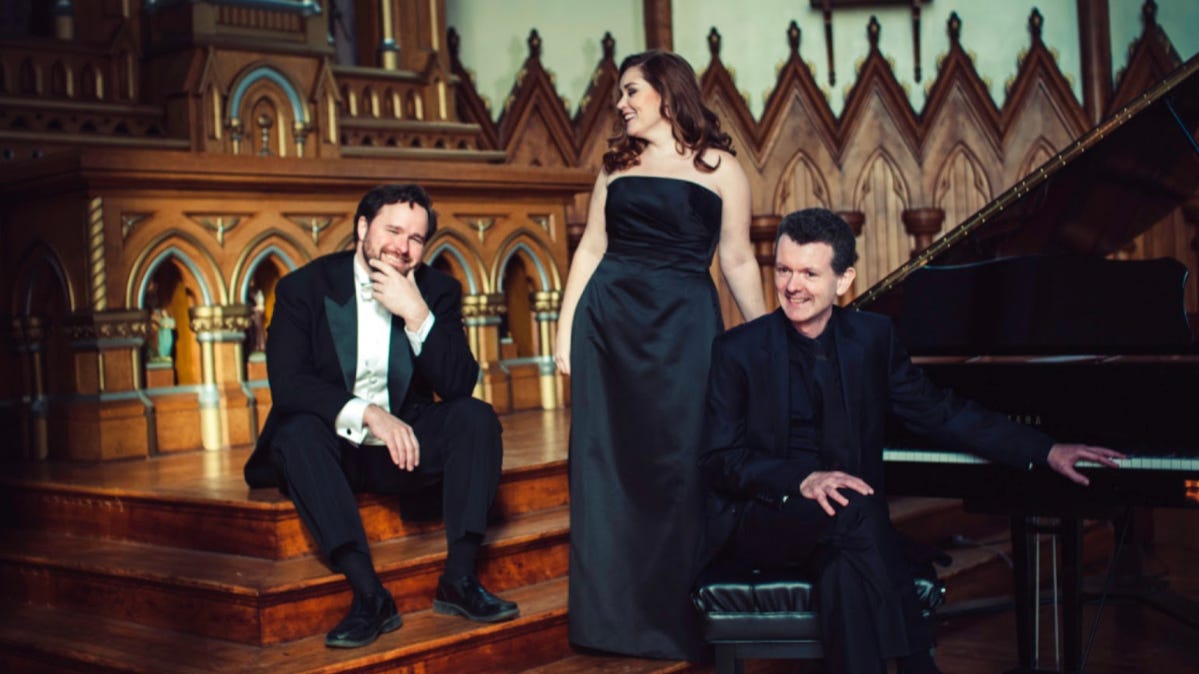
Composer Fiona Ryan writes:
While Schubert could assume many audience members would be familiar with the work on which “Lady of the Lake” was based, I knew I could not make that assumption, and therefore chose to write in a more operatic or theatrical way: many of my songs are essentially character sketches that hint at the larger plot, rather like film teasers.
“Song of a Warrior Woman” by Fiona M. Ryan from Lady of the Lake. Video by Tom Belding.
Composer Chia Yin Wu says:
Art song is an integral part of my creative endeavour because it is a marriage between distilled human thoughts/emotions and the warmth of human voice. When compared with a single art song and opera, art song cycle offers the best of these two worlds. It has the opera's ability to narrate an extended story and the single art song's ability to highlight significant poetic moments. I like that [art song] is concise. It says what it needs to say and not more.
Composer Saman Shahi writes:
I have to really live with the poem, and the life story of the author before I can get in their world. In “Breathing in the Shadows” I feel like I was able to gain access to their thoughts and lives like a friend, and combine it with music. My favorite thing about “Breathing in the Shadows” is that the writing process was very intuitive and not very formal. I was playful, I was improvising, I was listening to my inner ear as opposed to relying solely on my technical abilities as a composer.
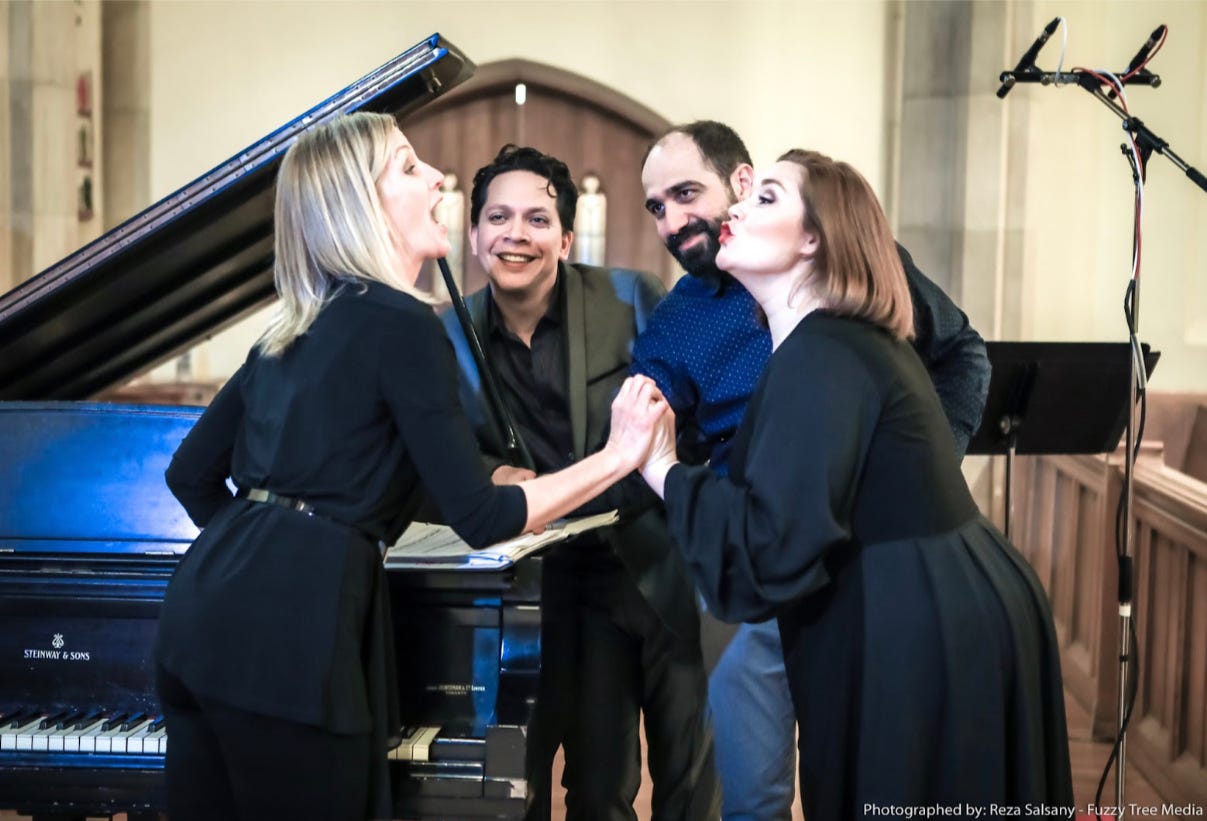
When we hear, watch, or perform art song, we are the recipients of the entire ensemble’s coalescence. The cast list grows with each new artist that comes to the work and engages with it, whether it is folkloric or floral, story or snapshot. I am most invested in cultivating these relationships; the more cast members, the merrier.
“A la una yo nasi” by Elisha Denburg from Four Ladino Folk Songs. Video by Leaf Music.
Maureen Batt is a soprano, recording artist, artistic director and educator based in Halifax, Nova Scotia. Maureen’s career focuses on celebrating music by living composers through her opera company Essential Opera, her concert series Crossing Borders, and her discography. Check out 2x-ECMA-winning album Lighthouse here.
The Winterreise Project at ProVoce Studio by Don Melady, MSc(Ed) MD CCFP(EM)(COE) FCFP
Art song is alive and well in Toronto, not just on concert stages and among professional performers but among music enthusiasts as well. Testimony of this reality comes from The Winterreise Project and the weekend recently organized by Tina Torlone’s ProVoce Voice Studio.
During the pandemic, Dr. Erika Crinò (DMA, Piano Performance, UBC) and Professor John Warden (retired Professor Emeritus of Classics, U of T) started collaborating, at great distance, on the songs in Schubert’s Winterreise. They started with a few Lieder and, as the pandemic continued, they ended up working in depth on the whole cycle. Erika and John were each in their homes; the former in Trieste, Italy, where she is member of the piano faculty at the Conservatory of Perugia; the latter in Toronto where he is active as a solo and choral singer and poet. Like everyone during those years, Erika and John found ways to overcome the challenges of distance and to make music even though separated by thousands of kilometres. They worked through all 24 of the songs in Schubert’s Winterreise using Zoom and an iterative process of recording, discussion, analysis, and writing. They created a written record of their observations, discoveries, and disagreements!
In the spring of 2024, Erika returned to Toronto. She and John wanted to share their project with a larger audience – and a larger number of performers. They worked with Tina Torlone, with whose studio they are both associated, to expand the project. John agreed to perform eight of the songs and Tina assigned the other sixteen to some of her advanced students as well as herself.
Over the weekend of April 12-14th, 2024, a total of nine singers presented the entire Winterreise cycle to friends, family, and the public in two Liederabende. The singers – Tina Torlone, Joanna Manning, Amanda Vallejos, Maria Case, Elizabeth McLeod, Lee Ramsay, Don Melady, Alex Chan, and John Warden - worked with three professional pianists and coaches - Dr. Erika Crinò, Dr. Joy Lee, and Gergely Szokolay. During these two evenings, the songs were performed in order, introduced in groups of four with comments by Erika and John. Participants were also offered an 80-page commentary, co-written by Erika and John, which contains an analysis of each of the songs. In it, Erika focuses on how harmonic, structural, and physically pianistic insights affect and colour the interpretation of the text, while John’s contributions are those of someone with a lifetime of experience as both a poet and a literary scholar. It is based on the ideas they exchanged in their journey together through the cycle. It is not intended as an academic study.2 Fabulous Sachertorte and Topfentorte were waiting for all participants at the end!
Pro Voce Studio’s response has been so enthusiastic that there is already a plan for an art song project to study and perform different settings of chosen texts during the next year.
Don Melady is a Professor at the Faculty of Medicine at the University of Toronto. He is also the director of the Geriatric Emergency Medicine Fellowship at Mount Sinai Hospital and the Toronto Chair of the Clinical Practice Committee of the International Federation of Emergency Medicine. His book, Creating a Geriatric Emergency Department, is available from Cambridge University Press.
Xavier Leroux’s La solitaire (1887) by Michaela Chiste, soprano & Theodore Chow, pianist
The life of Xavier Leroux (1863-1919) shares interesting parallels with the famed composer Claude Debussy. Both studied at the Conservatoire de Paris and each won the prestigious Prix de Rome; Debussy in 1884, and Leroux in 1885. However, Debussy was disapproved of by his professors at the Conservatoire de Paris for his radical approach to composition, while Leroux was hired as professor of harmony.
Leroux’s La solitaire (1887) is an early work featuring poetry by Armand Renaud, a contemporary French poet often influenced by Persian and Japanese poetry. 3 The first song in La solitaire, “Le Nil,” evokes a couple blissfully floating across the Nile River in their boat, revelling in their love. The second song, “Le délire,” describes a woman being approached by various merchants in a busy market, each offering her their finest trinkets to celebrate her beauty. The final song in the set, “Gazelles,” references the tale of Majnun and Layla, a Persian story of star-crossed lovers wherein the spurned man wanders the desert after Layla is forced to marry another. The song describes how Majnun sees Layla in the graceful gazelles he hunts and implores other hunters not to kill the gazelles, as it would be like slaying his love.
Listen to Canadian singer Michaela Chiste and pianist Theodore Chow perform La solitaire below, or on your favourite streaming service! Bravi.
Echo North is a voice-piano duo consisting of soprano Michaela Chiste and pianist Theodore Chow. Though there is very little music that the two of them do not enjoy performing, Echo North takes every opportunity to dig up and present unusual, hidden gems in the art song repertoire. Echo North is currently planning a concert tour that includes exclusively Canadian art songs in an effort to bring these underperformed and underappreciated pieces of music into the public eye.
Editor’s note: Readers, do you have a little known song cycle you’d like to share with the Art Song Canada community? Write to us at info@artsongfoundation.ca to be featured!
Interested readers can request a copy of this document by contacting erikacrino@gmail.com
A cultural interest in distant lands and cultures can be felt in much of the art produced in France in the late 19th century. From 1855 onwards, Paris was the site of several Expositions Universelles, exposing French composers to diverse sounds which they borrowed to suit their own creative uses. In his 1978 book, Orientalism, the literary critic Edward Said characterized early 19th century Paris as the capital of the Orientalist world. (Echo North)




